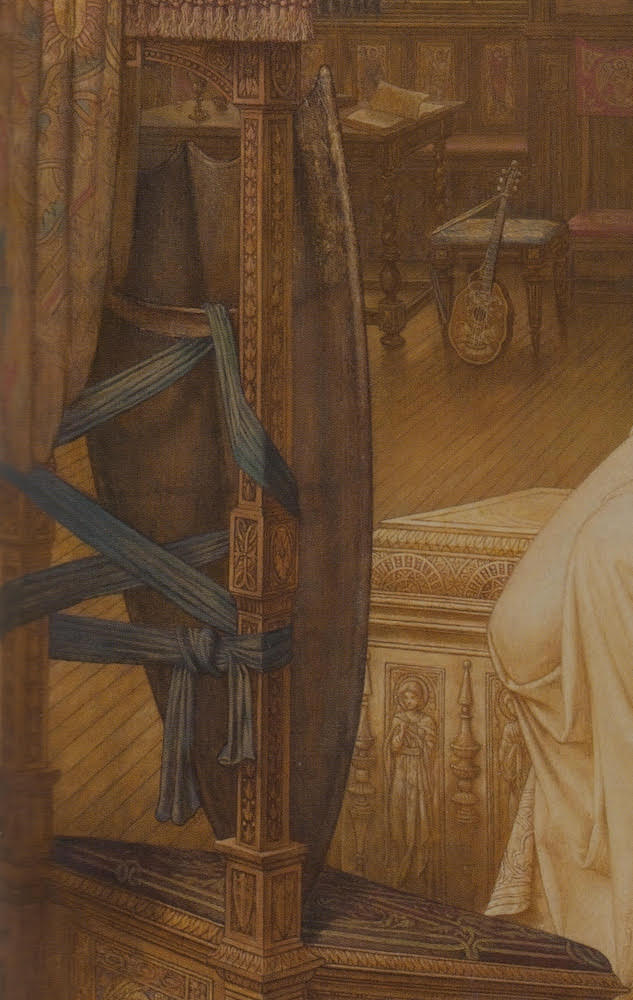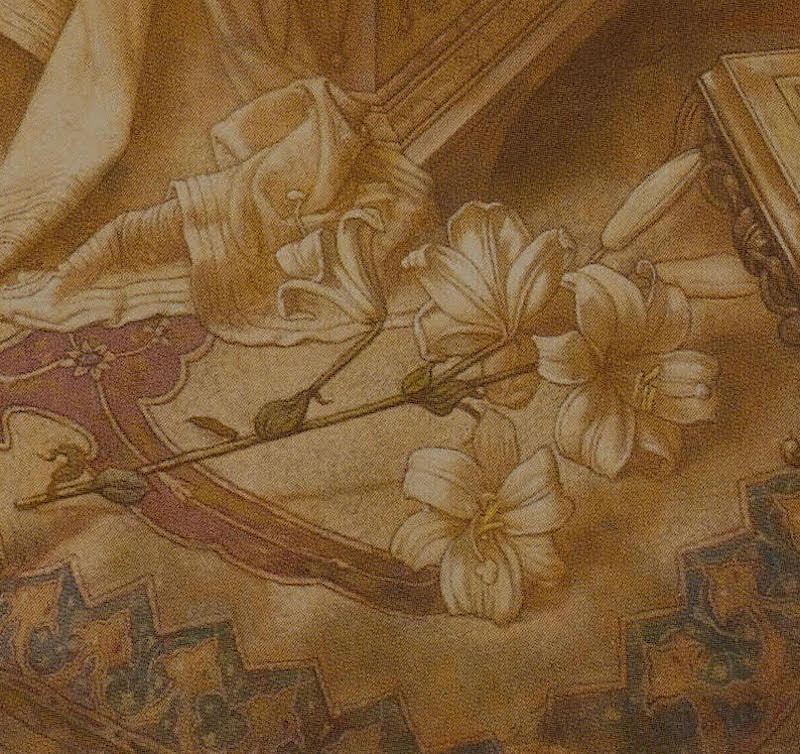
Elaine. 1891. Oil on canvas. 31 x 23 inches (79 x 58.5 cm). The Pérez Simón Collection. Image courtesy of Sotheby's. [Click on all the images on this page to enlarge them.]
Strudwick exhibited this work, his first on an Arthurian theme, at the New Gallery in 1891. Inscribed on an old label on the backing board were lines from Alfred Tennyson's The Idylls of the King:
Leaving her household and good father, climb'd
That eastern tower, and entering barr'd her door,
Stript off the case, and read the naked shield,
Now guess'd a hidden meaning in his arms,
Now made a pretty history to herself
Of every dint a sword had beaten in it.
The story of Elaine, the lily maid of Astolat and the daughter of King Pelles, is recounted in the seventh book of Idylls of the King, "Lancelot and Elaine." Lancelot visited Astolat on his way to Camelot to take part in a tournament. He exchanged his shield for the unmarked shield of King Pelles' son Sir Torre so that he could take part in the joust without being recognised. This is how his battered shield came to be in the possession of Elaine. She had lived a sheltered life indulged by her adoring father and knew little of the world or of men (Mancoff 78). Lancelot was wounded in the tournament and Elaine nursed him back to health. She fell in love with the handsome knight but her love was not reciprocated because Lancelot was already in love with Queen Guenevere. Her father was powerless to get Elaine to abandon her hopeless obsessive love, which obviously could have no happy outcome. Eventually Elaine dies of unrequited love and her body is taken by barge to King Arthur's court at Camelot. She had written a letter to Lancelot that was to be given to him after her death telling him that "I loved you, and my love had no return, And therefore my true love has been my death." Debra Mancoff has put a feminist interpretation on her death: "Elaine did not simply die for love, she died in defiance of her proper place and her father's counsel. A streak of will flawed her feminine nature and self-destruction, rather than Lancelot's rejection, caused her untimely and unnecessary death" (78). The episode of Elaine in her barge floating down to Camelot was the subject most often portrayed in Victorian art such as Henry Wallis's Elaine, exhibited at the Royal Academy in 1861. The work closest in theme to Strudwick's painting was Arthur Hughes's Elaine with the Armour of Lancelot of 1867 (Tate Britain). Frederick Sandys, however, chose to portray Elaine in her role as one of the guardians of the Holy Grail in his King Pelles' Daughter Bearing the Vessel of the Sangrael of 1861.
Christopher Newall has described Strudwick's painting which depicts an early incident in the story of Elaine and Lancelot:
In Strudwick's version of the subject, Elaine is shown in the private apartment of her father's castle of Astolat. Seated on a carved wooden coffer, she looks intently at the shield of Lancelot, which she has placed on a prie-dieu (as if it were some kind of holy relic). With it is shown part of the embroidered drapery that Elaine had made to keep and protect the shield. Lying at her feet is a lily, the flower of martyrdom with which her legend has been associated since Malory told her story in Morte D'Arthur, and from which she took her name the Lily Maid of Astolat. In the treatment of her anguished expression, and in the way she clasps her hands, Strudwick captures the agonising torment of one who is hopelessly in love, and thus anticipates the tragic consequences of that love. [38 & 40]

Closer view of Lancelot's shield secured to the prie-dieu.
Véronique Gerard-Powell has given her own very discerning reading of the meaning of Strudwick's picture, noting that he
interweaves two episodes taken from the beginning and end of the story. He painstakingly reconstructs a peaceful medieval interior, in the spirit of contemporary Arts and Crafts decoration. Elaine, "the Lily maid of Astolat" and perfect young mistress of the house sits alone. In front of her, tied to the prie-dieu, is the shield Lancelot entrusted to her safekeeping so that he would not be identified at a tournament. This recalls the episode from the beginning of the poem when, still a child, Elaine encounters Love for the first time:
High in the chamber up a tower to the east
Guarded the sacred shield of Lancelot;
Which first she placed where morning's earliest ray
Might strike it, and awake her with the gleam;
The open book and the abandoned lute allude to the hours spent by the young girl imagining the prowess of her hero as she gazes fixedly at his shield. But the prie-dieu with its precious shield now inspires a different kind of devotion, emblematic of the ravages of love. Elaine is no longer a happy child. Rejected by Lancelot, her only thought is, "O love, if death be sweeter, let me die." She addresses him with a simple, direct force, "I have gone mad. I love you: let me die." Against the muted tones of the interior, lit by diffuse golden-brown light, her hands and face communicate her despair as she sinks into madness. [179]

Closer view of The Marian lilies by Elaine's feet.
Madelaine Emerald Thiele greatly admires this particular painting:
The most beautiful of Strudwick's works, which I suspect Rossetti would have heartened to, is Elaine, a beautiful Arthurian subject drawn from Tennyson's Idylls of the King (1859). Elaine, the very poorly treated lover of Lancelot, gazes despairingly at his shield which is propped up in front of her. The colours are so muted, that you take a moment to settle upon the shield. Elaine's features are exquisite and the pathos is compelling. Strudwick's attention to detail is, in itself, legendary: the Marian lilies, the dowry chest, the rug, her sandal, the angelic filled walls. As G.B. Shaw wrote in 1891 "Holbein, Hogarth, Bellini were not more exact and straightforward than Strudwick." The beautifully muted palette of Elaine is so tender and golden, that her forlorn expression feels all the more strained. Her romantic love is displayed for us as having taken on sacramental qualities, as she sits before a pulpit. This painting is a beautifully testimony of all that is wonderful about Pre-Raphaelitism and British art of the nineteenth century. It may, by some, be considered wistful or whimsical, over sentimental, and somehow cloying, but the attention to detail, the mastery of line, colour, and composition is superb.
Contemporary Reviews of the Painting
When this painting was shown at the New Gallery in 1891 the reviewer for The Art Journal largely dismissed it: "It does not appear necessary to describe in detail, Mr. J.M. Strudwick's Elaine , at the aspect of which all who are acquainted with his frigid yet prettily wrought pre-Raphaelitism can easily guess" (189). M.H. Spielmann the critic of The Magazine of Art, however, found this to be a good example of Strudwick's art: "Of Mr. J.M. Strudwick's Elaine we need say nothing save that it closely resembles Mr. Burne-Jones's art. Few of its predecessors have been more to our taste than the present example" (261). The Magazine of Art reproduced an engraving of the painting as well on page 263.
F. G. Stephens in The Athenaeum not surprisingly wrote a scathing review, finding the work over-refined in its technique and insincere in its handling of the subject:
Though quite as laborious, Mr. Strudwick's Elaine (17) is, technically speaking, the antithesis of Mr. Poynter's contributions. The scene is the interior of the maiden's tower-chamber, where she guarded and studied the shield of Sir Lancelot. She is attired in ivory-like white, and is seated upon a coffer. The escutcheon hangs before upon a prie-dieu. Sweet and beautiful, but somewhat inane and passionless, she looks more pleasing than empassioned, and her attitude is not more marked by depth of feeling than her expression. These elements, no less than the draperies, accessories, background, architecture, and other details of the picture, have been laboured to the utmost of a stippling method of execution, which is as conventional as it is weak and unreal, and much less complete and studious than its smoothness would suggest. The monotony of brown in the half tints, and the lack of realism in the light and shade of this puzzling and insincere work, are as artificial as the design is sentimental and devoid of fire. We are quite willing to accept the conventions Mr. Strudwick or any one else may please to adopt, but, doing so, we must needs demand they shall want neither 'go' nor the genuine and sterling accomplishments which are conspicuously absent here. [610]
The painting initially failed to sell but eventually it entered the collection of his patron, William Imrie, of Mosley Hill, Liverpool. The Berlin Photographic Company published the picture as a photogravure, thereby making Strudwick's image available to a wider audience, as it later did for the works of Edward Burne-Jones in 1900.
Links to Related Material
- Elaine as Subject in Literature and the Visual Arts
- The Legend of King Arthur: Pilgrimage, Place and the Pre-Raphaelites (review of a book edited by Natalie Rigby)
- Myths and Legends in Victorian Culture (sitemap)
Bibliography
Gerard-Powell, Véronique. A Victorian Obsession. The Pérez Simón Collection at Leighton House Museum. London: Leighton House Museum, 2014, 178-79.
Kolsteren, Steven. "The Pre-Raphaelite Art of John Melhuish Strudwick (1849-1937)." The Journal of Pre-Raphaelite and Aesthetic Studies I:2 (Fall 1988):11, no. 20.
Mancoff, Debra N. The Return of King Arthur: The Legend through Victorian Eyes. London: Harry N. Abrams, Inc., 1995.
Newall, Christopher. Victorian and Edwardian Art. London: Sotheby's (14 December 2006): lot 118, 38-43. https://www.sothebys.com/en/auctions/ecatalogue/2006/victorian-edwardian-art-l06132/lot.118.html
Shaw, George Bernard. "J. M. Strudwick." The Art Journal LIII (April 1891): 100.
Spielmann, Marion H. "Current Art. The New Gallery." The Magazine of Art XIV (1891): 259-63.
Stephens, Frederic George. "Fine Arts. The New Gallery." The Athenaeum No. 3315 (9 May 1891): 609-12.
"The Summer Exhibitions at Home and Abroad. II – The Academy and the New Gallery. The Art Journal LIII (1891): 183-90.
Thiele, Madelaine Emerald. "John Melhuish Strudwick." https://madeleineemeraldthiele.wordpress.com/2015/06/26/john-melhuish-strudwick/
Created 1 October 2025